Your Friday Cellist Playing the “Psycho” Theme on 8 Cellos While Dressed as Norman Bates’ Mother
We’re still going to keep taking our shoes off at TSA checkpoints forever though? Just to be safe?
— southpaw (@nycsouthpaw) April 19, 2022
Jarring
Here’s a packaging idea that sounds good on the surface, but has a bit of a downside. Via Core77, Italian dairy products maker Bontà Divina sells their flavored dessert creams glass jars that are designed to be re-used as coffee or espresso mugs.
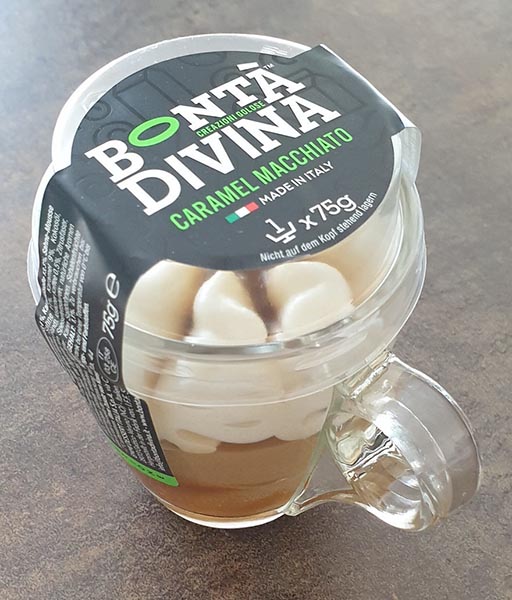
Great idea—avoid plastic and keep discarded packaging out of landfills by having it serve a useful post-packaging function. Still, if one is overly fond of Bontà Divina dessert creams, one could certainly amass a substantial collection of coffee mugs. Logistically, it probably wouldn’t be practical for them to have a takeback program so the glass packages could be reused should one’s mug collection hit critical mass, but at least glass is recyclable.
Signs of the Times Part the Infinity: Oh, Deer
Geez, just how fast were these animals crossing? pic.twitter.com/HA61lMQwpV
— Paul Myers (@pulmyears) April 13, 2022
Hand Over the Cash
Those who find paying via credit card or even via mobile phone too cumbersome and time-consuming can now pay for items using microchips embedded in their hands. Developed by British-Polish company Walletmor, the chip became available last year. Via the BBC:
Walletmor’s chip, which weighs less than a gram and is little bigger than a grain of rice, is comprised of a tiny microchip and an antenna encased in a biopolymer - a naturally sourced material, similar to plastic.
Mr Paprota adds that it is entirely safe, has regulatory approval, works immediately after being implanted, and will stay firmly in place. It also does not require a battery, or other power source. The firm says it has now sold more than 500 of the chips.
The technology Walletmor uses is near-field communication or NFC, the contactless payment system in smartphones. Other payment implants are based on radio-frequency identification (RFID), which is the similar technology typically found in physical contactless debit and credit cards.
The immediate fear is that the chips could be used to track people—a fear usually felt by people whom no one would ever want to track. However, the reading distance is quite small, so anyone tracking the chip would have better luck simply physically following the person.

Supposedly the implanting procedure hurts about as much as a brief pinch. No word on the extraction process when it needs to be upgraded, which it almost certainly will.
Good-Bye
it’s very telling that the people behind connected things companies ALWAYS think they can just disappear and nobody will notice all the dead devices they’ve left in their wake https://t.co/36zdmbkirC
— Internet of Shit (@internetofshit) April 19, 2022
Ad Hawk
If you’re ever interested in taking a little trip back in time, the Richmond (Va.) Times-Dispatch has just made available an online archive of its ads from the 1980s. This includes “high technology” products, housewares, video games, new movies, and everything else that a local newspaper would advertise. This will be nostalgic for some of us, bewildering and mind-boggling to others, and amusing to just about everyone.
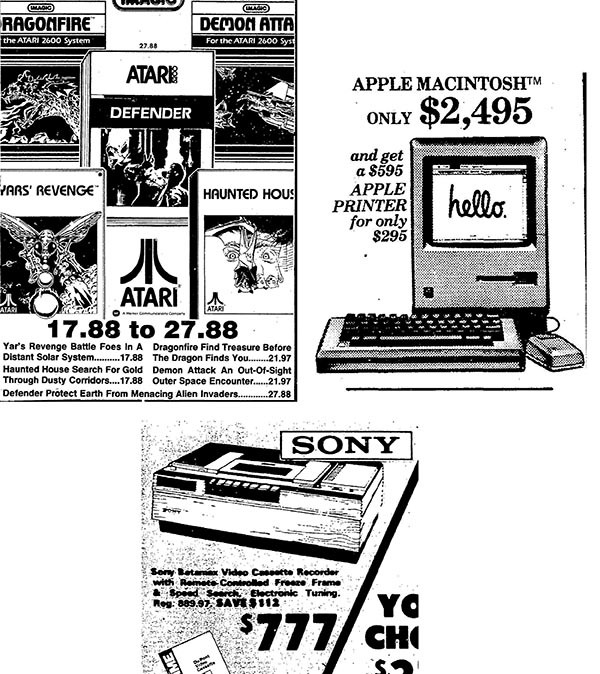
Yar’s Revenge….
A Reboot We’d Like to See
Who you gonna call? pic.twitter.com/wgGrdZDL7J
— Marshall Julius ???? (@MarshallJulius) April 13, 2022
Front Page Story
Via Boing Boing, here is a cool story—almost literally torn from the headlines—about how the front page of the Lewiston (Ida.) Tribune contained the clues needed to lead to a stolen wallet arrest. First off:
Jami Johnson lost her wallet on December 11, 2007, when she left it on the counter at the Zip Trip convenience store in Clarkston, Washington. A surveillance video showed a man pick it up and walk out of the store with it.
Two days later, the man, Michael Millhouse, was arrested and charged with theft. That was fast—how did the cops nab him so quickly?
The Lewiston Tribune had published a frame from the surveillance video on its front page, directly below a four-column photo of Millhouse decorating a local window for the holidays. He was identified by name and was even wearing the same clothing as in the surveillance photo.
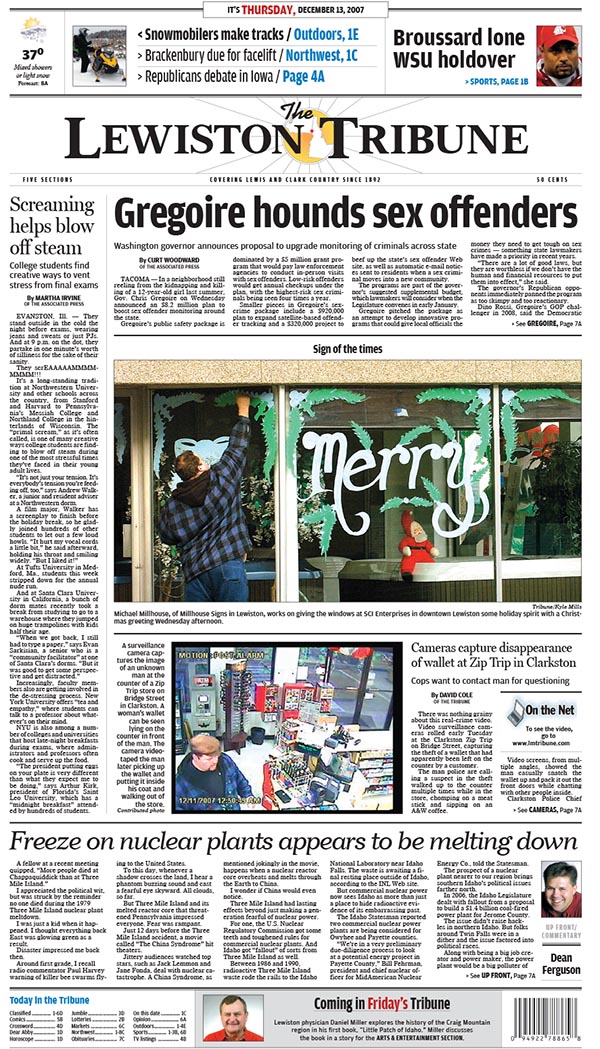
It’s regrettable that Millhouse owned Millhouse Signs of Lewiston, reflecting badly on the sign business, and while front page publicity for a window graphics is usually good, sometimes it can backfire. Our professional advice for sign business owners: don’t nick wallets.
Call the Grammar Police or the Actual Police?
World still needs copy editors pic.twitter.com/fLMwE7ki2H
— Jason Isbell (@JasonIsbell) April 17, 2022
AI-Yi-Yi: Really Impossible Burger
In this space, we have covered many different applications for Artificial Intelligence, including the ability to have AI create images based on a description. Now, via Fast Company, Moritz Stefaner has tweaked an AI image generator to create realistic images of food.
Stefaner typed words like Michelin star chef, deconstructed, and amuse-gueule into the generator, hoping to evoke the intricate plating of fine dining establishments like Eleven Madison Park or Alinea. And, suffice to say, his plan worked. The images he created are completely convincing plates that you could imagine being served at any 3-Michelin-starred restaurant.

Hmm…Kind of looks like something you’d find in the back of the fridge after about eight months. Still…
These hallucinations, of course, are trained into the software, which was fed countless labeled images to understand how to draw the objects. And there is no better window into the AI’s superficial logic than in Mortiz’s “fine dining high end Michelin star closeup burger”—on top, it’s a pile of rare ground beef, capped with a shiny brioche bun. But on the bottom, where the other bun should be? That’s a coral-like pile of something vaguely edible. In other words, the burger starts at Red Robin and ends with Noma. And while it’s funny, this image also demonstrates how little these AI models understand about the content they generate.
Then again, we’ve been to restaurants that had badly color-managed and printed menu photos that were less appetizing.
That’s the Only Problem with Bridgerton?
The sad news for fans of the @Netflix series, #Bridgerton, is that its producers made no effort to fix the ghastly tick mark & atrocious spacing in the header of Lady Whistledown’s scandal sheet.
— Museum of Printing (@MOPrinting) April 19, 2022
She’s purchasing more ink for Seasons 3 & 4. How about buying an apostrophe or two? pic.twitter.com/AUvXHeWxpb
Being of Sound Mind
For better or worse, the noises that technology makes have become the soundtrack to our lives. For example, here in the Around the Web Cultural Accretion Bunker, during the summer when we periodically emerge from the hermetically sealed AtW Creation Chamber, there is a bird whose call sounds exactly like the Direct Message alert noise in Slack. Nicknamed the “Slackbird,” it helps make psychotherapy the lucrative field it is.
At any rate, given that technology changes rapidly, the soundtrack to our lives also changes often. To help preserve these audio remnants of the past, the online Museum of Endangered Sounds retains samples of all these noises. It was launched in 2012 by Brendan Chilcutt, “as a way to preserve the sounds made famous by my favorite old technologies and electronics equipment. For instance, the textured rattle and hum of a VHS tape being sucked into the womb of a 1983 JVC HR-7100 VCR.” It’s specific, we’ll give it that.
The AOL Instant Messenger alert noise, the Mac startup noise, a rotary phone—all are there to be explored.
It appears that Chilcutt has stopped adding sounds around the mid-2010s, so there are plenty of more recent examples that should be preserved for posterity, or at the very least to explore Pavlovian responses to some of these sounds.
Things to Come
If Twitter goes away, can we go back to reading and supporting newspapers?
— Dan Rather (@DanRather) April 14, 2022
Deadline Café
I hope our publisher doesn’t hear about this—some of us could be forcibly sent there. Via Thrillist: “This Cafe Won’t Let Writers Leave Until They Hit Their Deadlines.”
The Manuscript Writing Cafe, which opened last week in Tokyo’s Koenji neighborhood, was created specifically for writers. To book time at the cafe, patrons must be doing some kind of writing, from novels and magazine articles to copywriters and even manga storyboarding, so long as the pen is virtually hitting paper. The other requirement for the cafe stay is an intended writing goal for your time there.
They provide power and chargers, WiFi, and unlimited coffee refills. But there is a dark side:
Writers can also request different levels of verbal pressure from staff members to make sure progress is being made. Every 30 minutes, to give writers more of a sense of urgency and help them hit their deadline, writers are charged 150 yen or $1.20. Not only will patrons be charged every half hour, but customers also can't leave until they achieve the day’s writing goal or the cafe closes for the night.
It’s a safe bet Basecamp is involved, as well.
Signs of the Times Part the Infinity: Employee of the Month
Maybe not the best-looking, but certainly the most accurate: pic.twitter.com/AhvtEFn78B
— Steve Schilling (@BluGold77) April 17, 2022
Graphene Goes to the Final Frontier
Was it a good week for graphene news? It’s always a good week for graphene news! Graphene is going into space! University students from the Netherlands and Chile will be using graphene test devices manufactured by Applied Nanolayers to measure the impact of space travel and direct space exposure on conductive graphene devices. Says Graphene-Info:
Applied Nanolayers and Technical University of Delft module specialists worked together on the specification of graphene materials and the physical devices required for space flight qualification. The resulting devices will test how graphene components withstand the vibration, radiation and temperature conditions of space, and the data generated will be used to give device developers verified graphene performance data to aid device design. Graphene’s ability to improve the sensitivity and accuracy of sensors used for navigation and astronomical observation is crucially important for future space travel.
Dog Doors of Perception
I've got a lot of time for this... https://t.co/dgZJLlUlA9
— Dan Walker (@mrdanwalker) April 20, 2022
Sticker Shock
Do you compost your food waste? You should, especially if you are into gardening, as it a great way to enrich the soil while reducing the need for chemical fertilizers and reducing methane emissions from landfills, lowering your carbon footprint. Says The Verge:
Composting is about accelerating the decomposition of organic matter. Your kitchen scraps and lawn clippings are all going to rot eventually. But a compost pile gets it done faster and, ideally, with minimal smells — finished compost smells like forest floor — and fewer greenhouse gas emissions. The same anaerobic bacteria that make rotting garbage smell so bad also emit methane; home composting focuses on boosting aerobic decomposition, which is both more sustainable and less disgusting.
Many things can be composted, and some are better than others:
For home composters, vegetable scraps and fruit peels are often a source of nitrogen, an integral part of the chemistry of a compost heap. Nitrogen feeds the microorganisms that break down the compost, generating heat in the process. Too little nitrogen, and a pile will stay cold and will break down slowly. Too much, and it starts to smell very bad. Maintaining the balance between nitrogen and carbon is key to composting at home. (Other common nitrogen sources include grass clippings, used coffee grounds, and — for the open-minded home composter — urine).
Yeah, well, we’ll eliminate that last item, as it were.
But, as composters know, there are certain items that should be kept out of the compost pile or bin and one in particular: produce labels.
Alas, the produce stickers ride alongside the nutrient-rich kitchen waste. They cling to a spent orange rind; they linger on a discarded banana peel; they’re brushed into the compost bucket with a pile of woody kale stems and carrot tops. It requires hypervigilance to prevent a produce sticker from entering a compost pile.
What’s the harm?
Produce stickers, which are often made of plastic, will maintain their shape and sometimes their bright colors, though they often wash out to a blinding white. When compost has fully broken down, they stand out like a sore thumb — perfect little ovals, circles, and rectangles contrasting sharply against the dark brown earth of finished compost.
One gets the sense that the problem is more aesthetic—but do we really want bits of plastic contaminating our gardens and lawns?
Both Cheverton and Hohman think that the stickers are more of an annoyance than a real problem. “The earth would probably be fine if we didn’t fish the stickers out of the compost,” says Cheverton. “But the solution is just so easy it’s frustrating that no grower / packer is willing to just switch to biodegradable paper stickers.”
“I could say it causes a little angst over the sheer amount of plastic that permeates our world,” says Hohman. “It’s symbolic of the problem.” He called the stickers “a 10,000-year monument to that time I bought a couple over-ripe kiwis and a tomato.”
Of course, we could just do a better job of encouraging produce consumers to remove the stickers before tossing the waste in the composter.
Waka Waka
My dog accidentally swallowed a whole bag of Scrabble tiles. We took him to the vet to get him checked out. No word yet…
— mariana Z???????????? (@mariana057) April 9, 2022
Michael, Walk Your Boat Ashore
This is either rather clever or kind of creepy, although it’s possible it could be both. Via Laughing Squid, Bellingham, Wash.’s Hard Drive Marine has introduced a boat with robotic legs that can walk itself onto shore and then back into the water.
Our unique line of vessels, designed as working service boats, eliminates the need for docking and ferrying on rugged, remote coastlines. …This design works for loading and unloading but stops the boat from running and performing well at any speed when water conditions are choppy or rough.
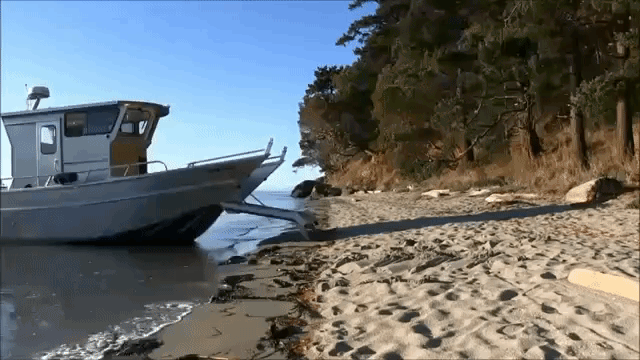
Could we call this a roboat?
All Maps Amazing and Terrible
6% of the Chinese population lives in the West, the other 94% lives in the East pic.twitter.com/B030vj6iCF
— Amazing Maps™ (@amazingmap) April 12, 2022
Moon on flag vs. flag on Moon pic.twitter.com/5T7OyW7OKi
— Terrible Maps (@TerribleMaps) April 14, 2022
Semi-Colander
If you love a salad spinner as much as we do, but want a simpler version, this “Drop Colander,” designed by Italian industrial designer Viviana Degrandi, is a great idea. Via Core77:
While it won't wash a salad big enough for four, it's designed to be loaded with berries, cherry tomatoes, herbs or greens. Once loaded the inner handle is rotated, closing it; then water can be run through the hollow handle and into the sphere.

The Drop Colander is available at MoMA Design Store, which sells them for $30. Hmm…
Blue Light Special
There are now more road comics still doing "Attention Kmart shoppers" bits than there are Kmarts. https://t.co/8XzMsdXpF0
— J. Elvis Weinstein (@JElvisWeinstein) April 11, 2022
Ooh, Mommy
Is nothing safe from the inexorable march of technology? What could be more low-tech and practical than a pair of chopsticks? But, researchers in Japan are working on electric chopsticks that will automatically make food taste saltier. Via The Guardian:
The chopsticks work by using electrical stimulation and a mini-computer worn on the eater’s wristband.
Great…fighting with technology (’cause you know you’ll have to) in order to eat a meal. Do go on:
The device transmits sodium ions from food, through the chopsticks, to the mouth where they create a sense of saltiness, according to Homei Miyashita, a professor at Meiji University in Tokyo, whose laboratory collaborated with the food and drink manufacturer Kirin to develop the device.
The team said they would refine the prototype and hoped to make the chopsticks available to consumers next year.
Now, we grant you, the objective behind this is actually quite sound: helping people reduce their salt intake—which can lead to high blood pressure, the biggest cause of heart attacks and strokes—while not sacrificing the salty taste we all love.
By the way, if Dr. Miyashita’s name sounds familiar, he turned up in Around the Web a few months ago as the inventor of a lickable TV screen that lets you taste what is on screen.
Good Question
why is it called a booster shot and not "shot, chaser"
— Ariel Edwards-Levy (@aedwardslevy) April 12, 2022
This Week in Printing, Publishing, and Media History
April 11
1976: The Apple I is created.
2007: American novelist, short story writer, and playwright Kurt Vonnegut dies (b. 1922). So it goes.
April 12
1932: American singer and ukulele player Tiny Tim (né Herbert Khaury) born.
1981: The first launch of a Space Shuttle (Columbia) takes place: The STS-1 mission.
1990: Jim Gary’s “Twentieth Century Dinosaurs” exhibition opens at the Smithsonian Institution National Museum of Natural History in Washington, D.C. He is the only sculptor ever invited to present a solo exhibition there.
1992: The Euro Disney Resort officially opens with its theme park Euro Disneyland; the resort and its park’s name are subsequently changed to Disneyland Paris.
April 13
1742: George Frideric Handel’s oratorio Messiah makes its world-premiere in Dublin, Ireland.
1743: American lawyer and politician, 3rd President of the United States Thomas Jefferson born.
1860: English-Belgian painter James Ensor born.
1870: The New York City Metropolitan Museum of Art is founded.
1899: American architect, game designer, and creator of Scrabble Alfred Mosher Butts born.
1901: French psychiatrist and academic Jacques Lacan born.
1923: Would you believe... American actor and director Don Adams born.
1906: Irish novelist, poet, and playwright, Nobel Prize laureate Samuel Beckett born.
1960: The United States launches Transit 1-B, the world’s first satellite navigation system.
1974: Western Union (in cooperation with NASA and Hughes Aircraft) launches the United States’ first commercial geosynchronous communications satellite, Westar 1.
April 14
1629: Dutch mathematician, astronomer, and physicist Christiaan Huygens born.
1828: Noah Webster copyrights the first edition of his dictionary.
1894: The first ever commercial motion picture house opened in New York City using 10 Kinetoscopes, a device for peep-show viewing of films.
1939: The Grapes of Wrath, by American author John Steinbeck is first published by the Viking Press.
April 15
1452: Italian painter, sculptor, and architect Leonardo da Vinci born.
1755: Samuel Johnson’s A Dictionary of the English Language is published in London.
1888: English poet and critic Matthew Arnold dies (b. 1822).
1924: Rand McNally publishes its first road atlas.
1980: French philosopher and author, Nobel Prize laureate Jean-Paul Sartre dies (b. 1905).
April 16
1844: French journalist, novelist, and poet, Nobel Prize laureate Anatole France born.
1871: Irish author, poet, and playwright John Millington Synge born.
1889: English actor, director, producer, screenwriter, and composer Charlie Chaplin born.
1947: Scottish singer-songwriter Gerry Rafferty born.
1994: American novelist and critic Ralph Ellison dies (b. 1913).
2012: The Pulitzer Prize winners were announced, it was the first time since 1977 that no book won the Fiction Prize.
April 17
838 years ago today. Still no official explanation. pic.twitter.com/Uinf1OJ5yv
— Tarhuwa (@Tarhuwa) April 17, 2022
1397: Geoffrey Chaucer tells The Canterbury Tales for the first time at the court of Richard II. Chaucer scholars have also identified this date (in 1387) as the start of the book’s pilgrimage to Canterbury.
1524: Giovanni da Verrazzano reaches New York harbor. (“If only there were a bridge here,” he is thought to have remarked.)
1790: American inventor, publisher, and politician, 6th President of Pennsylvania, Benjamin Franklin dies (b. 1706).
1897: American novelist and playwright Thornton Wilder born.
1955: English singer-songwriter and guitarist Pete Shelley born.
1957: English novelist, essayist, lyricist, and screenwriter Nick Hornby born.
2014: Colombian journalist and author, Nobel Prize laureate Gabriel García Márquez dies (b. 1927).
April 18
1918: American publisher, creator of CliffsNotes Clifton Hillegass born.
1930: The British Broadcasting Corporation announced that “there is no news” in their evening report.
2020: Europe surpasses 100,000 COVID-19 deaths.
April 19
1824: English-Scottish poet and playwright Lord Byron dies (b. 1788).
1927: Mae West is sentenced to 10 days in jail for obscenity for her play Sex.
1971: Launch of Salyut 1, the first space station.
1987: The Simpsons first appear as a series of shorts on The Tracey Ullman Show.
2013: American journalist, author, and publisher, founder of USA Today, Al Neuharth dies (b. 1924).
April 20
1535: The sun dog phenomenon observed over Stockholm and depicted in the famous painting Vädersolstavlan.
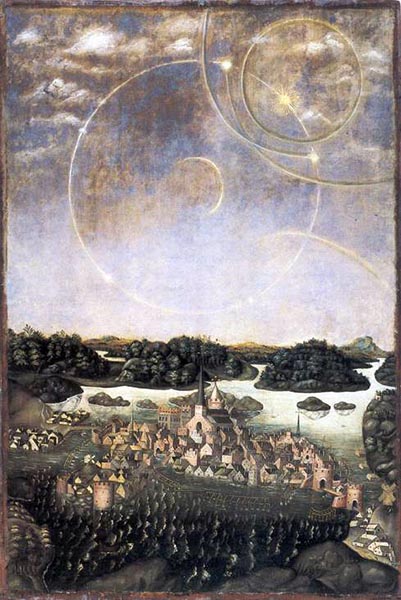
1893: Spanish painter and sculptor Joan Miró born.
1912: Anglo-Irish novelist and critic, creator of Count Dracula, Bram Stoker dies (b. 1847).
April 21
753 BC: Romulus founds Rome (traditional date), but not in a day.
1816: Cornish-English novelist and poet Charlotte Brontë born.
1838: Scottish-American environmentalist and author John Muir born.
1910: American novelist, humorist, and critic Mark Twain dies (b. 1835).
1934: The “Surgeon's Photograph,” the most famous photo allegedly showing the Loch Ness Monster, is published in the Daily Mail. (In 1999, it was revealed to have been a hoax.)
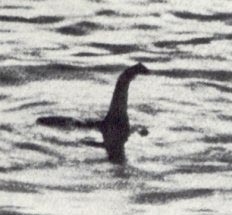
1977: Annie opens on Broadway.
April 22
1616: Spanish novelist, poet, and playwright Miguel de Cervantes dies (b. 1547).
1707: English novelist and playwright Henry Fielding born.
1724: German anthropologist, philosopher, and academic Immanuel Kant born.
1876: The first game in the history of the National League was played at the Jefferson Street Grounds in Philadelphia. This game is often pointed to as the beginning of Major League Baseball.
1899: Novelist and critic Vladimir Nabokov born.
1977: Optical fiber is first used to carry live telephone traffic.
April 23
1616: English playwright and poet William Shakespeare dies (b. 1564).
1850: English poet and author William Wordsworth dies (b. 1770).
1985: Coca-Cola changes its formula and releases New Coke. The response is overwhelmingly negative, and the original formula is back on the market in less than three months.
2005: The first ever YouTube video, titled “Me at the zoo,” was published by user “jawed.”
April 24
1704: The first regular newspaper in British Colonial America, The Boston News-Letter, is published.
1731: English journalist, novelist, and spy Daniel Defoe dies (b. 1660).
1800: The United States Library of Congress is established when President John Adams signs legislation to appropriate $5,000 to purchase “such books as may be necessary for the use of Congress.”
1905: American novelist, poet, and literary critic Robert Penn Warren born.
1940: B is for Birthday—American author Sue Grafton born.
1990: The Hubble Space Telescope is launched from the Space Shuttle Discovery.















Discussion
Join the discussion Sign In or Become a Member, doing so is simple and free